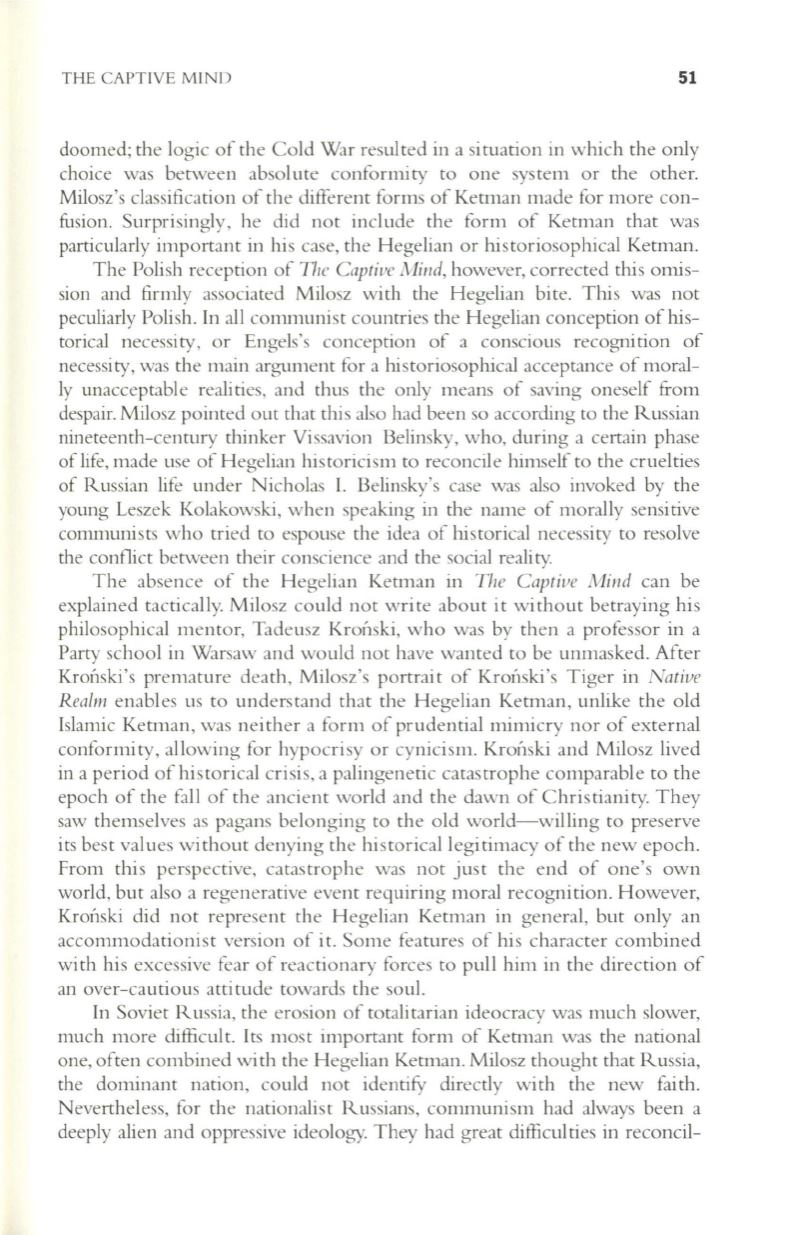
THE CAPT IVE MINI)
51
doomed; the logic o f the Cold War resul ted in a situation in w hi ch the only
choice was between absolute confo rmi ty to one sys tem o r the other.
Milosz's classifi ca tio n of the different forms of Ketman made fo r mo re con–
fusion. Surpri singly, he did no t include the form o f Ketman that was
particularly important in hi s case, the Hegelian or hi sto riosophi cal Ketman .
The Poli sh reception of
The Captive Mind,
however, corrected thi s onus–
sion and firmly associated Milosz with the Hegelian bite. T hi s was not
peculiarly Poli sh.
In
all communi st countries the Hegelian conception of his–
torical necessity, or Engels's conceptio n of a conscious recogJution of
necessity, was the main argument fo r a hi sto ri osophical acceptance of moral–
ly unacceptabl e realities, and thus the only means of saving oneself from
despair. Milosz pointed out that thi s also had been so according to the Russian
nineteenth-centu ry thinker Vi ssavion Belinsky, who, during a certain phase
of life, made use of Hegelian hi sto ri cism to reconcil e himself to the cruelties
of Russian life under Nicholas
I.
Belinsky's case was also invoked by the
young Leszek Kolakowski , w hen speaking in the name of mo rally sensitive
communi sts w ho tried to espouse the idea of hi sto rical necessity to resolve
the conflict between their conscience and the social real ity.
Th e absence o f the Hege li an Ketman in
The Captive Milld
can be
explained tacti cally. Mil osz could no t write about it witho ut betraying hi s
philosophi cal mento r, Tadeusz Krol1 ski , w ho was by th en a pro fessor in a
Party school in Warsaw and wo uld no t have wanted to be unmasked . After
Krol1ski 's premature dea th , Mil osz's portrait of Krollski 's T ige r in
Native
Realm
enabl es us to understand that the H egelian Ketman, unlike the old
Islamic Ketman , was neith er a fo rm o f prudenti al mimi cry no r o f external
confo rmi ty, all owing fo r hypocri sy o r cyni cism . Krol1 ski and Mil osz lived
in a peri od of hi sto ri cal cri sis, a palingeneti c catas troph e comparabl e to the
epoch of the fall o f the ancient world and the dawn o f C hri sti ani ty. They
saw th emselves as paga ns belo nging to th e old world- willing to preserve
its bes t values w itho ut denying the hi stori cal legitimacy of th e new epoch .
From thi s perspective, ca tas troph e was not just th e end of o ne's own
world , but also a regenerative event requiring moral recogniti o n . However,
Krol1ski did no t represent the Hegelian Ketman in general, but only an
accommodati o ni st versio n o f it. Some fea tures o f hi s character combined
with hi s excessive fear o f reacti o nary forces to pull him in th e direction of
an over-cautious atti tude towa rds the soul.
In
Soviet Russia, the erosion of to tali tarian ideocracy was much slower,
much more diffi cul
t.
Its mos t impo rtant form of Ketman was the national
one, often combined wi th the Hegeli an Ketman. Mil osz thought that Russia,
the donunant nati on, could no t identi fY directly with the new faith.
Neverthel ess, fo r the nati onali st Russians, communi sm had always been a
deeply ali en and oppressive ideology. They had great diffi cul ti es in reconcil-


